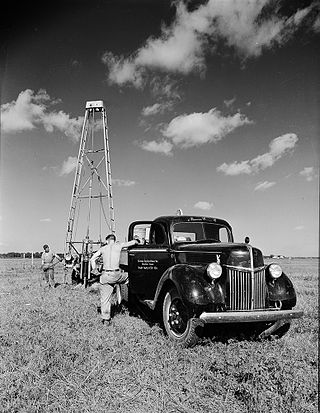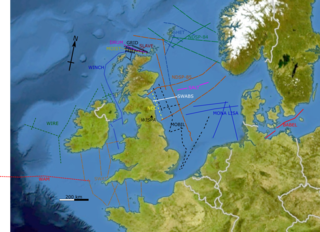
WesternGeco is a geophysical services company. It is headquartered in Schlumberger House on the property of London Gatwick Airport in Crawley, West Sussex, in Greater London.

Reflection seismology is a method of exploration geophysics that uses the principles of seismology to estimate the properties of the Earth's subsurface from reflected seismic waves. The method requires a controlled seismic source of energy, such as dynamite or Tovex blast, a specialized air gun or a seismic vibrator. Reflection seismology is similar to sonar and echolocation.
Conexant Systems, Inc. was an American-based software developer and fabless semiconductor company that developed technology for voice and audio processing, imaging and modems. The company began as a division of Rockwell International, before being spun off as a public company. Conexant itself then spun off several business units, creating independent public companies which included Skyworks Solutions and Mindspeed Technologies.

Magnetotellurics (MT) is an electromagnetic geophysical method for inferring the earth's subsurface electrical conductivity from measurements of natural geomagnetic and geoelectric field variation at the Earth's surface.

A seismic source is a device that generates controlled seismic energy used to perform both reflection and refraction seismic surveys. A seismic source can be simple, such as dynamite, or it can use more sophisticated technology, such as a specialized air gun. Seismic sources can provide single pulses or continuous sweeps of energy, generating seismic waves, which travel through a medium such as water or layers of rocks. Some of the waves then reflect and refract and are recorded by receivers, such as geophones or hydrophones.

CGG SA (CGG) is a multinational geoscience technology services company that specializes on solving complex natural resource, environmental and infrastructure challenges.

Geophysical imaging is a minimally destructive geophysical technique that investigates the subsurface of a terrestrial planet. Geophysical imaging is a noninvasive imaging technique with a high parametrical and spatio-temporal resolution. It can be used to model a surface or object understudy in 2D or 3D as well as monitor changes.
Seismic migration is the process by which seismic events are geometrically re-located in either space or time to the location the event occurred in the subsurface rather than the location that it was recorded at the surface, thereby creating a more accurate image of the subsurface. This process is necessary to overcome the limitations of geophysical methods imposed by areas of complex geology, such as: faults, salt bodies, folding, etc.
Refraction microtremor (ReMi) is a surface-performed geophysical survey developed by Dr. John Louie (and others) based on previously existing principles of evaluating surface waves and in particular Rayleigh waves. The refraction microtremor technology was developed at the University of Nevada and is owned by the State of Nevada. Optim of Reno, Nevada has the exclusive license to develop the technology, and SeisOpt® ReMi™ has been available commercially from Optim since 2004. Since Rayleigh waves are dispersive, the propagating waves are measured along a linear seismic array and evaluated relative to wave frequency and slowness (or the inverse of the velocity). Due to the dispersive characteristics of higher frequency waves travelling through the more shallow conditions and lower frequency waves passing through deeper materials, a 1-D subsurface profile can be generated based on the velocity with depth.

A seismic vibrator is a truck-mounted or buggy-mounted device that is capable of injecting low-frequency vibrations into the earth. It is one of a number of seismic sources used in reflection seismology. The ‘Vibroseis’ exploration technique was developed by the Continental Oil Company (Conoco) during the 1950s and was a trademark until the company's patent lapsed.
In geophysics, seismic inversion is the process of transforming seismic reflection data into a quantitative rock-property description of a reservoir. Seismic inversion may be pre- or post-stack, deterministic, random or geostatistical; it typically includes other reservoir measurements such as well logs and cores.
Andrew S. Long is an Australian geophysicist. He has a PhD in geophysics (1996) from the University of Western Australia, and a post-doctoral term at Stanford University. He is a leader in the application of geophysical technologies to exploration for oil and gas in marine areas, and has written and presented several papers at the Society of Exploration Geophysicists (SEG), the European Association of Geoscientists and Engineers (EAGE), the Australian Society of Exploration Geophysicists (ASEG), the Australian Petroleum Production & Exploration Association (APPEA) and many other international conventions and journals.
A synthetic seismogram is the result of forward modelling the seismic response of an input earth model, which is defined in terms of 1D, 2D or 3D variations in physical properties. In hydrocarbon exploration this is used to provide a 'tie' between changes in rock properties in a borehole and seismic reflection data at the same location. It can also be used either to test possible interpretation models for 2D and 3D seismic data or to model the response of the predicted geology as an aid to planning a seismic reflection survey. In the processing of wide-angle reflection and refraction (WARR) data, synthetic seismograms are used to further constrain the results of seismic tomography. In earthquake seismology, synthetic seismograms are used either to match the predicted effects of a particular earthquake source fault model with observed seismometer records or to help constrain the Earth's velocity structure. Synthetic seismograms are generated using specialized geophysical software.

Seismic inversion involves the set of methods which seismologists use to infer properties through physical measurements. Surface-wave inversion is the method by which elastic properties, density, and thickness of layers in the subsurface are obtained through analysis of surface-wave dispersion. The entire inversion process requires the gathering of seismic data, the creation of dispersion curves, and finally the inference of subsurface properties.
Shell Processing Support (SPS) is a set of formatted files used for exchanging Land 3D seismic data. They can also be used for 2D.
Mitcham Industries, Inc. was set up in 1987, and now is based in Huntsville, Texas. The company markets geophysical and other equipment to seismic data acquisition contractors conducting surveys on land, marsh, and marine areas, both shallow and deep water. There are mainly two segments operating in the company, namely an Equipment Leasing segment and an Equipment Manufacturing segment. In October 2011, the Company opened a new logistics and repair facility in Budapest, Hungary, and three months later, it opened two new subsidiaries, namely Mitcham Europe Ltd. and Mitcham Marine Leasing Pte Ltd. On September 21, 2015, Founder and CEO Billy F. Mitcham Jr. died, and Guy M. Malden and Robert P. Capps were installed as Co-Chief Executive Officers.

Seismic data acquisition is the first of the three distinct stages of seismic exploration, the other two being seismic data processing and seismic interpretation. Seismic acquisition requires the use of a seismic source at specified locations for a seismic survey, and the energy that travels within the subsurface as seismic waves generated by the source gets recorded at specified locations on the surface by what is known as receivers.
MESA is a seismic survey design software currently owned by ION Geophysical. The software provides set of tools for optimizing onshore, offshore and transition zone survey design and planning. The software comes with three licenses namely, MESA field, MESA Professional and MESA Expert.

The British Institutions Reflection Profiling Syndicate, better known by its acronym BIRPS, was set up to acquire deep seismic reflection profiles around the United Kingdom Continental Shelf (UKCS). It was formed, initially as BURPS, the British Universities Reflection Profiling Syndicate, involving geophysicists from the Natural Environment Research Council (NERC) and British Universities. After the involvement of other institutions the name was changed to BIRPS and by February 1981 NERC had approved funding for a four-year programme. The next ten years saw the collection of 12,000 km of deep seismic profiles around the British Isles. By the time NERC stopped funding the program in 1997, more than 20,000 km of data had been acquired.
Geospace Technologies Corporation is a manufacturer of specialized electronics and seismic data acquisition equipment used in the oil and gas industry. Geospace Technologies has been publicly traded on the NASDAQ stock exchange since November 1997.









